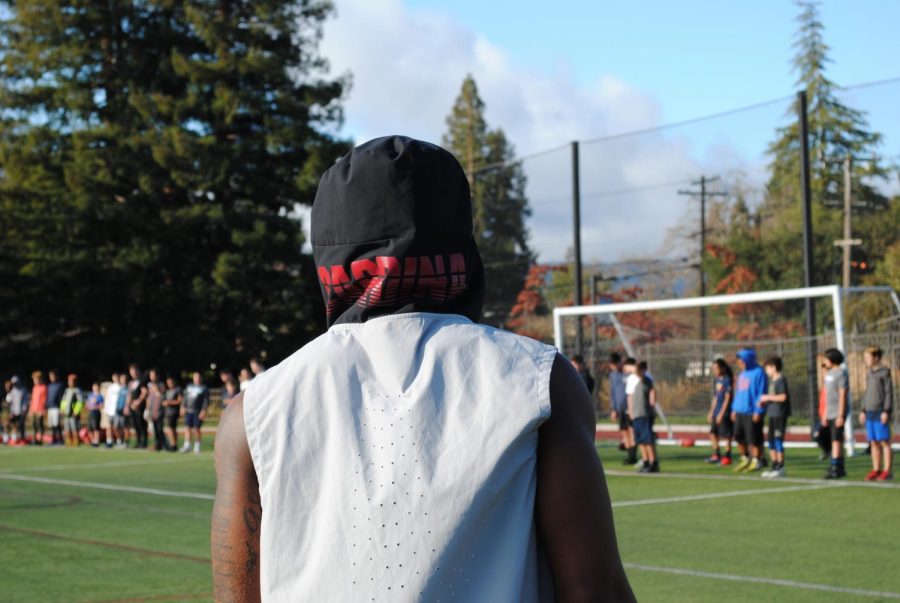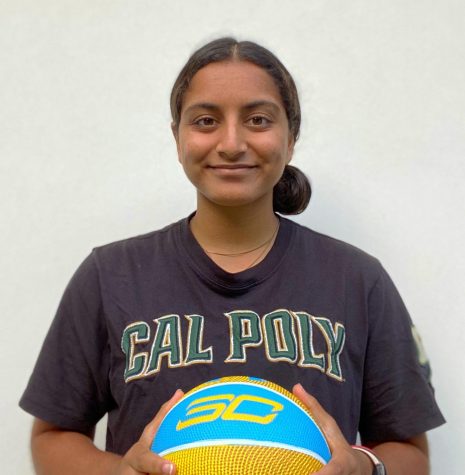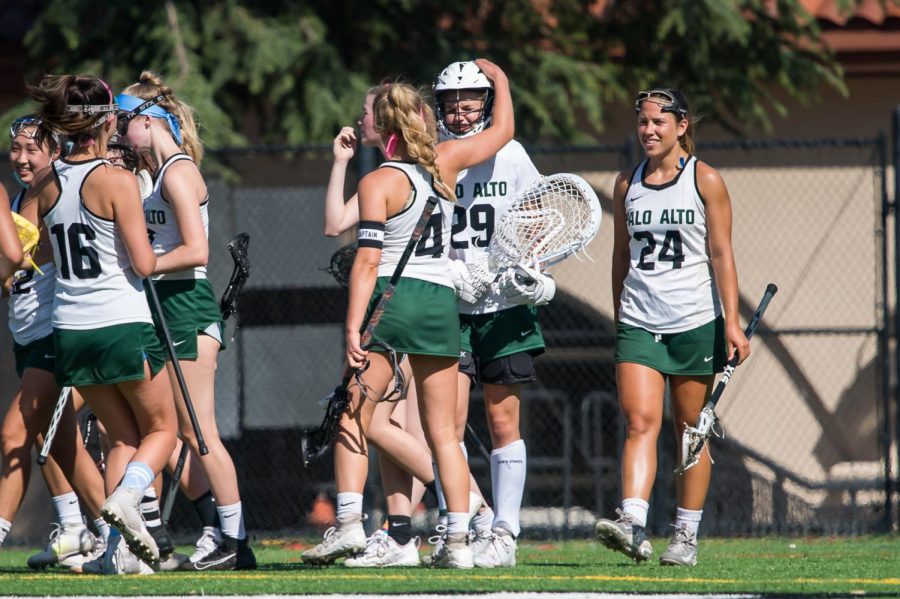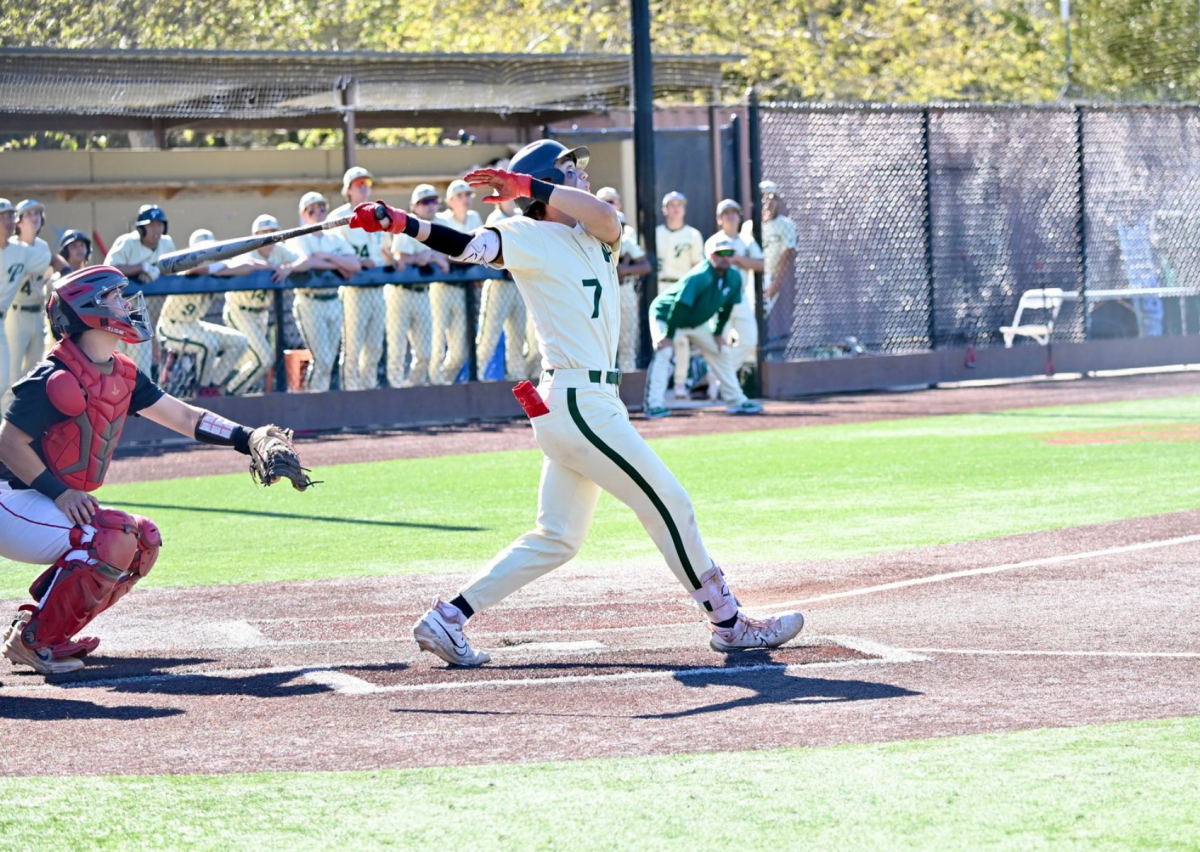> Athlete: Giving Players a Chance to be More
With California being the first state to pass a bill that allows college athletes to get paid with regulations, Stanford football hosts their first ever camp run by the athletes themselves. Their first camp, held at Hillview Middle School, had a huge show out of young athletes who look up to these players at the collegiate level.
February 20, 2020
“The arms will take you; the arms will set you free!” Treyjohn Butler says, cupping his hands around an imaginary football as young players individually sprint out at him. Ten feet in they make a sharp pivot, turn, and catch the ball over their right shoulder, if they’re speedy enough and they properly utilize those ever-important arms.
Down the field to the right, two campers crouch on the starting line, and, at the shrill whistle, spring forward into pads held by Stanford players which mimic a defensive line. Most campers can’t push the Stanford players back more than an inch, but considering their frame, an inch or two is more than deserving of the high fives and encouragement they receive.
In the center of the field, aspiring quarterbacks practice throwing into the hands of the older players and, further down, campers work on their footwork, navigating in and out of ladders and cones under the watchful eyes of the Stanford athletes. Amidst this bustling field, a tangible sensation of drive, focus, and fun can be felt. The heightened energy most likely stems from the novelty of the situation: this is the first Stanford football camp organized by Athlete’s Guide, and the occasion is all the more special considering it’s one of the first instances where athletes will be able to receive compensation for their college-athlete role.
For years, Stanford has hosted football camps for high schoolers and younger children. But in all previous years, those camps have been run by Stanford coaches. Stanford athletes have long had the opportunity to help with the camps; however, participation is on a voluntary basis, and the work is unpaid.
Athlete’s Guide is a new concept – a groundbreaking one. Aided by changes in NCAA legislature permitting college athletes to profit off of their own image, Daniel Marx, Reilly Madden, and Cole Dargan, the creators of the camp, envisioned a new reality for athletic clinics. Dargan compares it to Uber: why not offer a similar service where athletes can schedule one-on-one sessions with specific athletes? No more unspecific camps where a defensive back learns from a wide receiver; no more camps filled with too many young players taught by too few coaches. Within the new model, young players would be able to select a specific college athlete whose position, skills, or experience are most applicable or enticing. The young player would then continue to train under the watchful eye of that same athlete for multiple sessions. The athlete is no longer just a trainer; they’re a mentor.
“I participated in regular skills camp, which were overcrowded, not coached or mentored,” Dargan said. “They only focused on the biggest or fastest guy to be recruited.”
“[With Athlete’s Guide,] you get the chance to continue that relationship [with an active player] after camp,” Marx added.
Specifically, active players running the camp offers participants a unique perspective on life as an athlete. “They’re going to understand how to talk to the youth and offer a more holistic view about the larger context of being an athlete,” Dargan said.
Presently, the Athlete’s Guide’s trainer offerings are nondescript. Go on their website, and you’ll see the option to book “Softball Outfielder #1,” or “Women’s Soccer Midfielder #2.” Soon, that will change. Laws providing college-athletes an avenue to receive payment will be slow to come to fruition. But it’s a start to combat the shocking realities of life as an NCAA athlete.
Behind the glitz and glamour of NCAA victories, the cigar-lighting and the basketball net cutting, lies a grimmer truth that Athlete’s Guide is trying to combat: college players are, overwhelmingly, poor.
The statistics are staggering. According to a joint study conducted by the National College Players Association and Drexel University’s Department of Sport Management, 85 percent of players on those full scholarships living on campus live below the federal poverty line; the figure is 86 percent for those living off campus.
Even more startling is the value of the players compared to the figures in their bank account. The fair market value of an average Football Bowl Subdivision football player was $121,048. It’s the kind of salary that would set most adults for life. It’s the kind of salary the coaches are paid – at the University of Texas, for instance, college coaches were paid an average of over $3.5 million each in 2010 while 100% of their football players received scholarships that left them living below the federal poverty line.
85 percent of players on those full scholarships living on campus live below the federal poverty line; the figure is 86 percent for those living off campus.
Dargan compares it to slave labor. “The NCAA covers up how many athletes live below the poverty line,” Dargan said. “They live how slaves live; they have money if they’re on the ‘reservation,’ but can’t do things outside of the team financially. Thousands of athletes join groups after graduation to find jobs, because if you don’t go to the NFL, you may end up as a plumber.” He mentions that there’s nothing wrong with the kinds of jobs available to the players after they graduate, but that to a player whose true value is in the hundreds of thousands of dollars, graduating “without even the experience of working at an ice cream shop on your resumé” sets players up for a life of financial instability.
Why not get a part time job? According to Business Insider, college athletes must contend with 30-hour per week time commitments solely from their sport – for some sports, that obligation jumps to 40 hours. Yet these athletes aren’t full-time workers for their school, as a professional athlete would be. Players are still expected to attend class full-time,.
Michael Williams, a senior defensive tackle at Stanford, says he and several teammates actually did work part-time, but found that balancing the job meant giving up on necessities as basic as sleep. “We all have these jobs and all work…but we have to sacrifice sleep towards making money,” Williams said. “It’s a give-and-take type of thing.”
The NCAA, of course, has rules and regulations in place to prevent student-athletes from spending too much time on their sport. But the definition of “too much” is subjective – and the regulations are simple to bypass. Athletes are currently meant to spend no more than 20 hours per week on official team activities. But according to a 2010 NCAA survey, no player across any sport practiced for less than 28 hours. It’s not hard to imagine a scenario in which an athlete, swamped with school-work, is implicitly told that an optional practice is not quite as optional as it seems; that if they want to keep their starting spot on the team, which the springy new player is gunning for, then some extra time in the weight room could do them some good. Completely optional, of course. Or is it?
“The extra work is all initiative, and it’s up to your own discretion what you want to put into it,” Dylan Boles, a defensive end, said. “Guys do take a considerable amount of time just outside of what is required through the program to dedicate to their craft. There’s a lot of guys that want to put extra time in the film room or out on the field or the weight room, or whatever it might be to better their game, so you have the regulated part of it that we abide by, but then also a lot of guys take that time to better themselves in their position.”
It may be true that at Stanford, the regulations really are abided by more thoroughly than at other schools. Marx, who played football for Stanford himself, had a vastly different experience than Dargan, who attended the University of South Carolina, did. According to Marx, his own awareness of the collegiate-athlete payment debate was limited.
“It’s not necessarily something I ever thought about,” Marx said. “I didn’t know how much went into it. There were less [stories of impoverished athletes] at Stanford, but you were on your own after [you graduated].”
Dargan, on the other hand, said money was at the forefront of everyone’s mind at University of South Carolina. “I did think about it, because in the South, you go to school to play sports,” Dargan said. “So everyone is thinking about the money and things that go into the game, and athletes are celebrities at school.”
And despite that celebrity status, Dargan has a host of harrowing anecdotes about players’ lack of ability to enjoy life as a normal college student. They simply didn’t have the money to do so.
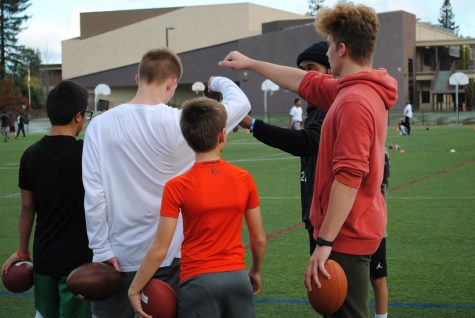
“I knew a current Seahawks player, Jadeveon Clowney, who was the No. 1 pick out of South Carolina,” Dargan said. “He had ten dollars in his bank account, but 400,000 followers. So no money, but he obviously could have had more, if he had access.”
He recounts a time when he saw a player sitting at a bar for hours while customers bustled around him. When Dargan approached him to ask why he wasn’t buying anything, the player told him he wasn’t able to pay. Dargan bought him drinks.
He remembers when a player at Notre Dame was left homeless, because the school had kicked him out of the dorm room once he transferred. Dargan let him sleep on his coach.
He recalls a year when South Carolina went to the Final Four – he went to every game to support them, even away games. After a UofSC win, Dargan went out to celebrate with the team, and found that none of the kids could pay for food. Dargan chipped in for their meals.
Dargan has carried those memories with him even now, years removed from college. It’s not something that’s easy to forget. And it was a central motivation to his and Marx’s desire to create Athlete’s Guide.
“We would hire a lot of athletes with only sports on their resume so players can get that ownership in the program,” Marx said. “And we saw that they start trying to improve the camp to sell it out, not just showing up to get a paycheck. They essentially start running a business.”
What really stood out to Marx was how the players truly took ownership of the camp. “When you give these players opportunities, they will amaze you in terms of what they can do,” Dargan said. He noted that when he saw them interacting with parents and taking the effort to ensure the wellbeing of the customers, he realized they were generating the life skills necessary to bolster a business. The chance to assume a leadership role where those players gained entrepreneurial ability, learned to run and improve a real business, is an extremely valuable opportunity to bolster their prospect of life after college.
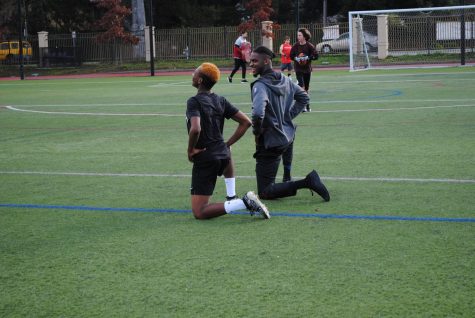
And more than that, it’s a chance for players to be more than just an athlete. It’s one of the least-discussed benefits of the new NCAA ruling. Players getting paid is something that should have been happening years ago. It’s a late step; better late than never. But it’s one that allows college athletes to form an identity based on more than their sport. They’ll no longer be athletes first, people second – that’s what Athlete’s Guide hopes. With opportunities like the one Athlete’s Guide provides, players will begin to see avenues to contribute to their community, to develop their skills, to explore life after college athletics. Because they’re more than athletes. They’re more than a debate about compensation.
“Generally, just giving back to the community is the primary goal, and just spreading the wealth, knowledge, and the wisdom that we’ve gained in our college ranks,” Swann said. ”Playing the sport, the detail and the technique that we can impart in the young kids will allow them to portray it in their games.
It’s honestly just sharing the love of our love, which is football.
— Dylan Boles
And of course, there is one force unifying campers, players, athletes, coaches, from Stanford, or University of South Carolina, or anywhere in between. It’s apparent when watching the players give words of encouragement to the players, slapping them on the back or taking the time to give personal advice after each and every catch. In spite of it all, these players aren’t here for the money. For them, this is about the next generation – it’s about forging a connection. And it’s obvious that, when given the chance to display it, these players are skilled, compassionate, driven individuals. They have much more to offer than what we already see on the turf. Now, finally, they have a chance to show it. “It’s critical for us to show a guiding way, for these kids to have somebody that’s been through it and is currently there to teach proper technique and give them some advice, and give them the knowledge to help improve their game,” Boles said. “It’s honestly just sharing the love of our love, which is football.”



